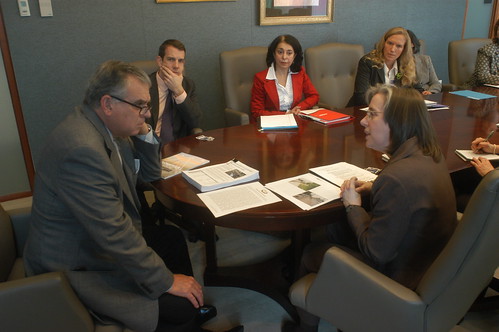U.S. Transportation Department makes good on promise to ensure our streets are made safer
Secretary of Transportation Ray LaHood issued a exciting new directive yesterday that officially shows DOT’s support for improving safety for walking and bicycling and the importance of integrating them into transportation systems — treating them as equal modes of transportation.
Last fall we released a report chronicling the tragedy of 76,000 preventable pedestrian deaths over the last 15 years. “Dangerous by Design” took a hard look at our often unsafe streets that are engineered for speeding traffic with little or no provision for people on foot, in wheelchairs or on a bicycle.
 |
| DSC_0376 Originally uploaded by Transportation for America |
When that report was released, we asked supporters like you across the country to sign a petition to Transportation Secretary Ray Lahood asking him to support Complete Streets at DOT, and more than 4,100 of you responded. We took that petition directly to Secretary Lahood back in November of 2008, and afterward, he told T4 America, “the right of way “belongs to pedestrians and bicyclists as well. The DOT Safety Council is going to look at this report and work with advocacy groups to ensure our streets are as safe as possible.”
Yesterday, Secretary Lahood and DOT responded by turning his words to us from November into official DOT policy with the release of a DOT “policy statement.”
The DOT policy is to incorporate safe and convenient walking and bicycling facilities into transportation projects. Every transportation agency, including DOT, has the responsibility to improve conditions and opportunities for walking and bicycling and to integrate walking and bicycling into their transportation systems. Because of the numerous individual and community benefits that walking and bicycling provide — including health, safety, environmental, transportation, and quality of life — transportation agencies are encouraged to go beyond minimum standards to provide safe and convenient facilities for these modes.
Or as he described it more simply on his Fastlane blog yesterday, “This is the end of favoring motorized transportation at the expense of non-motorized.”
We applaud the Secretary’s work on this issue and are especially thankful for the thousands of you who wrote a letter to Congress or signed our petition to Sec. Lahood urging him to use all the powers at DOT’s disposal to make safe, complete streets the norm all across America. Your voices were heard, and policy has changed.
“This is an issue that has been ignored far too long, even as thousands have died or been injured unnecessarily just by doing something as simple as trying to cross the street,” said T4 America director James Corless.
“We thank Secretary Lahood for his leadership at DOT and for elevating this urgent issue to the level of prominence that it deserves. Americans deserve have a safe route for walking to the store, walking their kids to school, or walking to the bus stop at the end of their block to get to work. Taking these simple steps to consider the needs of everyone who uses a street — bicyclist, pedestrian, or wheelchair user — is exactly what we were hoping for when we took our message into Secretary Lahood’s office last November. It can help us stay healthier by giving us one more option for travel, and Secretary Lahood is spot-on when he says that it’s a key part of making livable neighborhoods.”
This certainly doesn’t mean that the issue is over. As Barbara McCann with the National Complete Streets Coalition reminds us, there is still no official federal requirement for complete streets on projects the feds spend money on. And only a fraction of states, cities, and towns have rules on the books requiring them to ensure the safety of all users when they build or retrofit a street or road.
DOT is saying all the right things in this statement, but they need the legislative authority and money from Congress to line up with their excellent intentions.
So we’ve taken a first step. A big, important leap into a safer world for everyone who uses our streets. But there is more left to do.



















